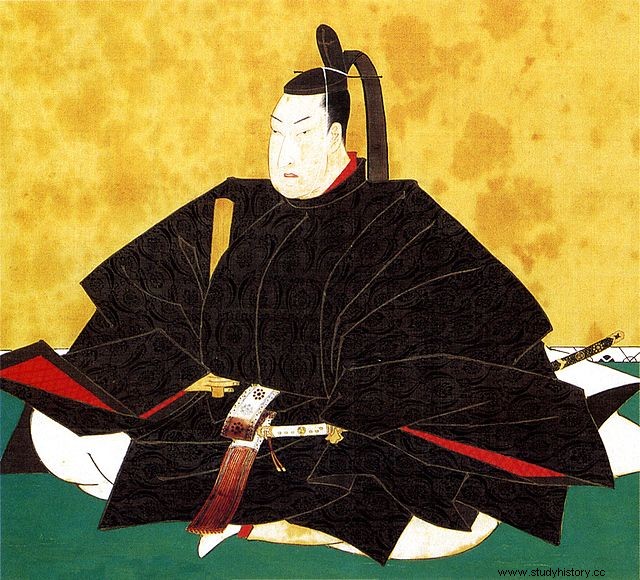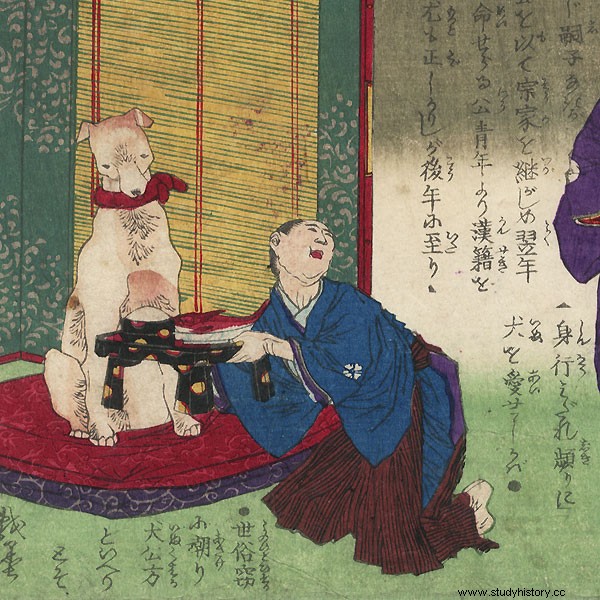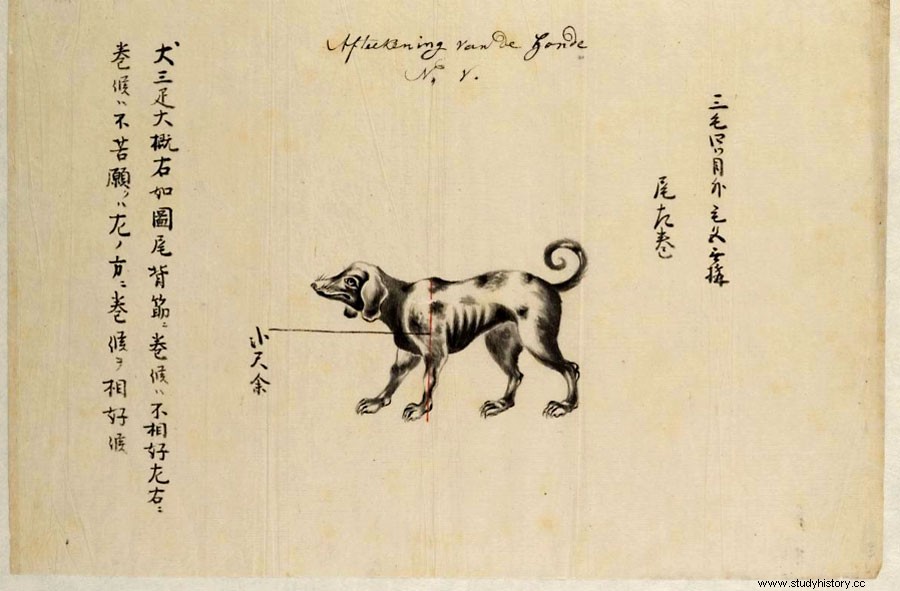Not always a life of dogs has been synonymous with hardships and disappointments. Back in 1690, Japan was an excellent place to be born a dog. By government decree, dogs, among other animals, were to be treated with deference and courtesy, under penalty of severe punishment. Every dog, from the most flea-ridden stray mutt to the lovable household pet, was pampered and revered beyond delirium. There were those who, with a touch of sarcasm, used pompous courtesy formulas when calling them, in the style of “ Your Honorable and Most Worthy Lordship of him ”, more typical of the imperial court of Kyoto than of the municipal kennel. Anything rather than incur the wrath of the Shogun, the fearsome Tokugawa Tsunayoshi , who had put these animals under the direct protection of him.

Tokugawa Tsunayoshi
The gossips said that, in Japan at the end of the s. XVII and principles of the XVIII, the dogs lived better than the people. And, although in truth they were not without reason, that statement is more than exaggerated. Now we will see why.
The island empire lived in times of peace and prosperity under the Tokugawa Shogunate . The population of Edo , the current Tokyo, was already around a million souls and was the de facto capital of the country. The hardships of the era of civil wars were a distant memory, and a new and thriving urban, bourgeois, modern culture was beginning to emerge. Until the fifth Shogun of the dynasty, Tsunayoshi , ascended the throne. The truth is that he did not enter with a very good foot. In reality, he was not even destined to rule. He had been educated as a scholar, a sage in the Confucian style, and since childhood he had remained oblivious to the martial uses of the instruction of a future Shogun. But he had to assume the position on the death of his brother, and that's where the friction began. Tsunayoshi never got along with the ethics of the samurai, the ideals of his caste, which earned him quite a bit of misunderstanding and quite a bit of bad press among his contemporaries.
It is said that Tsunayoshi, desperate for the lack of offspring to ensure the succession of the lineage, sought advice from a certain highly influential monk at court. Probably the root of the problem was rather the Shogun's homosexual tendencies, which did not help much in the matter of producing heirs, but the monk came up with a more esoteric explanation. The lack of offspring was a divine punishment for faults committed in a previous life. Tsunayoshi's past incarnations had taken so many lives that he had been left with karma made some foxes. In order to expunge such sins, he had to show compassion for the living beings around him in this present life. And, since the Shogun was born in the year of the dog, the monk suggested that he take said animal under his protection.

Said and done. The dogs became considered untouchable throughout the country. Both samurai and commoners were required to feed and shelter stray dogs. Any type of abuse, even verbal, inflicted on the animal was prohibited under penalty of death. Huge kennels were built at the expense of state coffers to house thousands of stray dogs. While the people were starving, the mongrels lived like a king, supported by tax money. If some unfortunate committed the audacity to try to defend himself from the attack of a feral dog, he inevitably ends up on the scaffold. Day in, day out, the executions followed one another. The infamous “laws on compassion towards living beings ”, which promulgated the inviolability of dogs and other animals, had plunged Japan into a true reign of terror. No one was safe from the executioner. Or, at least, that's what the black legend says. The chronicles present Tsunayoshi as an eccentric man with sadistic tendencies. Frivolous, capricious and with a touch of insanity, he was never a saint of the devotion of his subjects. Probably the friend Tsunayoshi was a guy with whom it was better not to argue (he had a tyrannical streak in his family), all right, but if we look more closely at his methods of government, we will discover a much more lucid ruler than is usually thought. paints.
The laws on compassion, his most famous legacy, were almost completely repealed after his death, and have been a source of no small joke throughout the centuries. That's where Tsunayoshi gets the cruel sanbenito of Inu-Kubo (the Shogun-Dog ). But, although in his day they were worth the ridicule of his countrymen, seen through the eyes of citizens of the 21st century, his policies do not seem so unreasonable.
In the first place, the object of those famous edicts was not only dogs, nor animals in general. Tsunayoshi began his crusade for compassion by prohibiting the abandonment of living beings, starting with babies and the elderly, who were often abandoned to their fate by their families so as not to have to feed them. He, too, did not forget to organize a social assistance system for vagrants and beggars, as well as to regulate the treatment of inmates in prisons to make it more humane. His objective was to promote compassion and harmonious coexistence among the society of the time, still clinging to customs and values typical of the Middle Ages . The Shogun's idea was to educate the people and get them out of barbarism, guiding them towards a more charitable model of life. This effort to inculcate positive values in their subjects and take them out of medieval obscurantism, even against the will of the subjects themselves, is not so different from what, around the same time, the enlightened Europeans were beginning to propose on the other side of the world. The bad thing, of course, was that the punishments for offenders were not short either. As avant-garde as his policies were, Tsunayoshi was a man of his time, and in feudal Japan they did not mess around when it came to dispensing justice.

All in all, some of Tsunayoshi's decrees propose things that today seem as sensible to us as prohibiting the mutilation of the tendons of the horses' legs (a very fashionable custom at the time to make them faster), loading them beyond the weight that they could reasonably bear, or abandon them to their fate when they fell ill, another sadly common practice. He also insisted on regulating indiscriminate hunting and fishing, placed limits on the sale of animals that died of disease for human consumption, and made it compulsory by law to bury the carcasses of dogs and other animals instead of leaving them to rot in the gutters, as was the case. the norm until then. Another of his great desires was to take a census of the country's canine population in order to be able to promptly return any lost dog to its owners, perhaps thinking of putting an end to the packs of feral dogs that swarmed through the fields and cities. Man's best friend was of particular concern to the Shogun, and for very good reason. The abandonment of dogs, an abominable and cruel practice where they exist (which to our shame still abounds today), was the source of many problems in those days. Having tens of thousands of semi-feral dogs roaming freely throughout the country does not seem like a very reassuring scenario. It is tempting to consider Tsunayoshi an environmentalist avant la lettre , but his obsession with animal welfare probably had more to do with improving public health and safety in villages and towns.
Uncompromising in pursuing his pious political agenda, Tsunayoshi harshly condemned violence towards animals, both domestic and wild, and went to great lengths to foster love and care for them. Yes, there were severe punishments for cases of mistreatment but, according to the records, the sentences do not exceed a few dozen, a figure well below those hundreds of summary executions attributed to him by his most furious critics. Interestingly, the penalties were applied quite equally:commoners, samurai and monks were punished in the same way.
Although the success of these laws was rather slim, the stubborn Shogun never gave up. He went on erre y erre, trying to get his people out of the burricie until his last breath. But however laudable his intentions were, the Japanese of the time did not always get the message. Each new decree seemed more abracadabra to them than the previous one. Most of them never fully understood why the government forced them to take care of their sick animals instead of disposing of them, as they had done until then, or to take care of stray dogs as if they were family.
Tsunayoshi was a great misunderstood. Far from the insane monster that traditional historiography presents us with, he was rather a lucid and advanced ruler at his time, although his undeniable eccentricity earned him misunderstanding and ridicule from those around him. Suffice it as an example this anecdote, surely apocryphal, but well illustrates the feeling of the moment. One summer day, two peasants were carrying the carcass of a dog through the outskirts of Edo. By order of the Shogun, they had been entrusted with the task of burying him. After several hours of walking, one of the long-suffering day laborers couldn't take it anymore and began to spit out toads and snakes from his mouth. When it was time for them to palm, he said, there would be no one to worry about giving them a decent burial, and instead there they were, in full sun, carrying a damn dog to bury it with all the honors. His compadre, with the typical bluntness of the children of Edo, limited himself to answering:« well, it could have been worse… imagine if the Shogun had been born in the year of the horse, instead of in the year of the dog «.
Collaboration of R. Ibarzabal
